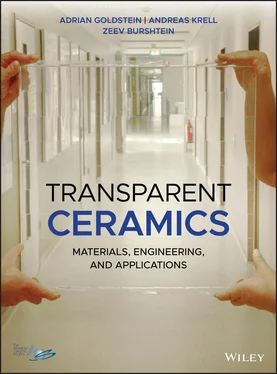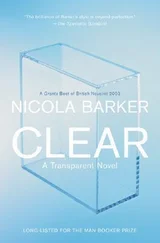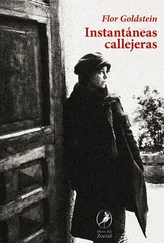u scatte... Figure 2.17 Relative scattering intensity as function of scattering angle in... Figure 2.18 Effect of pore size/
λ ratio on scattering intensity. (a) Th... Figure 2.19 Measured in-line transmission of single and polycrystalline Mg–A... Figure 2.20 In-line transmittance as a function of wavelength for polycrysta... Figure 2.21 Changes of transmission, for high density, variable grain size, ... Figure 2.22 Scattering parameters dependence on grain size. (a) Scattering i... Figure 2.23 Energy scheme of a
Cr 4+ion calculated par Racah constants o... Figure 2.24 Ni 2+cation's 3F ground-state level splitting by the spin/or... Figure 2.25 Correlation map (Terms scheme) demonstrating changes in the symm... Figure 2.26 Absorption curve and electronic levels scheme (deduced from spec... Figure 2.27 A Tanabe–Sugano diagram providing the energy separations between... Figure 2.28 Illustrated schematic scheme of the vibrational energy in a mult... Figure 2.29 Energy scheme of vibrational levels belonging to two different e... Figure 2.30 Squared vibrational wave functions describing the normal coordin... Figure 2.31 Correlation map for the 3H ground Term of an
n f 2configuration f... Figure 2.32 Energy scheme of Nd 3+ions of 4f 3configuration residing in ... Figure 2.33 Absorption spectrum of Fe 3+in disordered hosts (an aqueous ... Figure 2.34 Effective fluorescence lifetime of an excited, doubly ionized co... Figure 2.35 Schematic illustration of a
J = 2 state splittin... Figure 2.36 Schematic demonstration of possible resonance absorption peaks i... Figure 2.37 Energy levels considering the splitting of the states of a
D 3(u... Figure 2.38 Schematic energy level scheme related to an electron spin resona... Figure 2.39 Computer-generated spectrum of absorbed radio frequency power de... Figure 2.40 Electronic spectrum of a spinel containing 0.1% TiO 2, subjected ... Figure 2.41 Electron paramagnetic resonance signal (RT) of the specimen rele... Figure 2.42 The transmission spectra generated by the Cu species present in ... Figure 2.43 Cu 2p X-ray photoelectron spectroscopy signal in Zn-phosphate gl... Figure 2.44 EPR signal of Cu 2+, located in various Zn-phosphate glasses.... Figure 2.45 Optical spectrum of Cu accommodated (as Cu 2+in two coordina... Figure 2.46 Optical spectrum generated by Cu accommodated in a YAG host, whi... Figure 2.47 Cu 0nanometric clusters in P-Zn red glass (STEM image). Figure 2.48 Electronic states scheme of Er 3+cation. Figure 2.49 Electronic states of Yb 3+cation. Figure 2.50 Spectra produced by Nd 3+and Er 3+, respectively, located... Figure 2.51 Energy schemes describing the classification of solid materials ... Figure 2.52 Fermi–Dirac distribution function (occupancy of electronic state... Figure 2.53 Schematic illustration of a Morse potential, and its related har... Figure 2.54 Temporal snapshots of the atomic base normal mode states for dif... Figure 2.55 Graphic representation of acoustic vibration modes: (b) transver... Figure 2.56 Schematic illustration of transverse and longitudinal dispersion... Figure 2.57 Schematic illustration of optical transverse and longitudinal di... Figure 2.58 First Brillouin zone image of a face-centered cubic crystal (als... Figure 2.59 Phonon dispersion curves in GaAs along major symmetry directions... Figure 2.60 Calculated optical front surface reflectance of a dielectric cry... Figure 2.61 Semi-logarithmic plot of room temperature absorption coefficient... Figure 2.62 Black body radiation spectra at different temperatures. The spec... Figure 2.63 Complementary colors at opposing positions of a color wheel (giv...Figure 2.64 Transmission spectra of oxide ceramics with different coloring a...Figure 2.65 CIE 1931 Standard Observer. Virtual color matching functions.Figure 2.66 CIE 1931 color space chromaticity diagram. The outer curve is th...Figure 2.67
a -
b plane with
L -scale of the CIE-Lab color space diagram. In th...Figure 2.68 In-line transmission spectra of polished MgAl 2O 4spinel discs: T...Figure 2.69 Position of color of the transparent spinel discs of Table 2.8 i...Figure 2.70 Position of transparent spinel samples in CIE-Lab color space fo...
3 Chapter 3Figure 3.1 Pores average size, size distribution, morphology, and characteri...Figure 3.2 Monosized (∼1 μm), spherical amorphous silica particles arranged ...Figure 3.3 Silica glass parts fabricated by fast MW heating of compacts like...Figure 3.4 Yttria monosized spherical particles synthesized by wet chemistry...Figure 3.5 Selected, by centrifugation, fraction of Yb:SrF 2powder. (a) Coar...Figure 3.6 Discs resulting from hot pressing of (a) the coarse and (b) the f...Figure 3.7 Morphology of YAG powder prepared by spray-coprecipitation (state...Figure 3.8 Commercial spinel (MgAl 2O 4) powders with different particle sizes...Figure 3.9 Cryo-HRSEM micrographs of an aqueous suspension with 60% solid lo...Figure 3.10 Imaging of granules formed by various procedures (at ICSI, Haifa...Figure 3.11 Green density (as a function of compaction pressure) and microst...Figure 3.12 Schematic of surfactant molecules contact to particles surface (...Figure 3.13 Hydraulic pressure distribution across the cast and the mold in ...Figure 3.14 Cast porosity level as a function of particles size, shape, and ...Figure 3.15 Large (10 × 10 cm 2) plate formed by slip-casting (AS + HIP). (a)...Figure 3.16 Photo of alumina ceramic disc formed by slip-casting under magne...Figure 3.17 Degree of orientation achieved, in the green-specimen from which...Figure 3.18 Transmission spectra of alumina discs, slip-casted under magneti...Figure 3.19 Schematic presentation of the mechanism by which an external mag...Figure 3.20 Schematic description of the slip-casting under magnetic field. ...Figure 3.21 Pore size of green cakes formed by centrifugal deposition (initi...Figure 3.22 Agglomerates of particles, present in the green bodies and the i...Figure 3.23 Voids system pattern and distribution, in the microstructure of ...Figure 3.24 The void space distribution, at the start of the last stage of s...Figure 3.25 The pores coalescence process that may occur, as a result of mas...Figure 3.26 Pore coordination (by grains) number ( N ) in sintering ceramics. ...Figure 3.27 Equilibrium shape of a pore, during ceramics sintering, surround...Figure 3.28 Matter transport paths (ionic diffusion mechanism) as a function...Figure 3.29 Dependence of pore-boundary interaction on microstructural featu...Figure 3.30 Plot of the effective pressure divided by the applied pressure v...Figure 3.31 Pressure application configuration with indication of the type o...Figure 3.32 Applicator of an MW (2.45 GHz) sintering system (large L / λ ...Figure 3.33 Schematic of CVD reactor.Figure 3.34 Corning ware (opaque bowl) in both finished state (left) and ini...Figure 3.35 Rate, as a function of temperature (within the t g– t frange) leve...Figure 3.36 Free energy, as a function of composition and the ensuing phase ...Figure 3.37 Examples of phase separated glasses that may lead to glass-ceram...Figure 3.38 Transmission spectrum of typical soda-lime silicate glass. Band ...Figure 3.39 Transparent (moderately) ceramics fabricated by full glass cryst...Figure 3.40 Processing routes one can base on a sol–gel approach and types o...Figure 3.41 Bulk sol–gel transparent (nanometers pore containing gamma alumi...Figure 3.42 Pore size distribution curves of alumina xerogel fired, for 24 h...Figure 3.43 Massive shrinkage during sintering of xerogels (gel prepared fro...Figure 3.44 Transformation of polycrystalline ceramic to single crystal part...Figure 3.45 Demonstration of solid-state single-crystal formation I the case...Figure 3.46 Lasing efficiency of Nd:YAG ceramic compared with that of solid-...Figure 3.47 Spherical shape individual YAG single-crystals prepared by the s...Figure 3.48 Transmission spectrum of thin (0.8 mm) plates of BMT and distort...Figure 3.49 Ion beam preparation of ceramic granules (IKTS Dresden). (a) Ful...Figure 3.50 Schematics of green ceramic bodies of identical green density. (...Figure 3.51 Preparation of sections through highly porous Al 2O 3bodies prepa...Figure 3.54 Pore size distributions of green bodies prepared by slip-casting...Figure 3.52 Pore size distribution of green bodies formed by, respectively, ...Figure 3.53 Green microstructures of bodies made (a) by gel-casting and (b) ...Figure 3.55 Setup of laser tomography system used for scattering defects loc...Figure 3.56 Image of scattering defects topography in a single-crystal YAG (...Figure 3.57 Different visual evaluation of 0.06 mm thin translucent organic ...Figure 3.58 Effect of specimen thickness on the scattering loses. (a) Scatte...Figure 3.59 Chemical composition of grain-boundaries. (a) Map of Eu distribu...Figure 3.60 HRTEM image of a grain boundary in transparent spinel. (a) Undop...Figure 3.61 Segregation of Y 3+(1000 ppm of dopant) at the grain boundar...Figure 3.62 Nd penetration depth as a function of the plane type in alumina ...Figure 3.63 Distribution of Ce 3+over a YAG grain. (a) According to conf...Figure 3.64 Reflection spectra of TiO 2sintered in air (shows Ti 3+absor...Figure 3.65 Optical transmission curve of a Zr doped YAG and its EPR signal....Figure 3.66 Influences of (a) grain sizes and (b) of testing load on the Vic...Figure 3.67 The influence of grain size on the indentation size effect (the ...Figure 3.68 Increasing grain size of Al 2O 3ceramics promotes pull-out of gra...Figure 3.69 Improved performance of transparent spinel ceramic (MgAl 2O 4; by ...
Читать дальше











